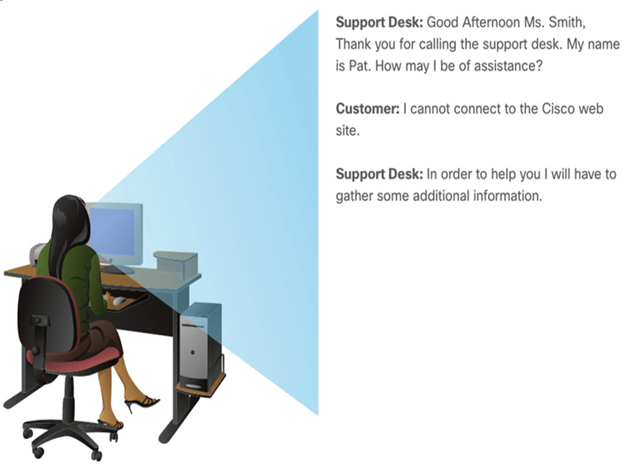When a network device is being configured, one or more DNS server addresses are provided that the DNS client can use for name resolution. Usually, the ISP provides the addresses to use for the DNS servers. When a user application requests to connect to a remote device by name, the requesting DNS client queries the name server to resolve the name to a numeric address.
Computer operating systems also have a utility called nslookup that allows the user to manually query the name servers to resolve a given host name. This utility can also be used to troubleshoot name resolution issues and to verify the current status of the name servers.
In Example 36-6, when the nslookup command is issued, the default DNS server configured for your host is displayed. The name of a host or domain can be entered at the nslookup prompt. The nslookup utility has many options available for extensive testing and verification of the DNS process.
Example 36-6 Looking Up Cisco Information with the nslookup Command
C:\Users>
nslookup
Default Server: dns-sj.cisco.com
Address: 171.70.168.183
www.cisco.com
Server: dns-sj.cisco.com
Address: 171.70.168.183
Name: origin-www.cisco.com
Addresses: 2001:420:1101:1::a
173.37.145.84
Aliases: www.cisco.comcisco.netacad.net
Server: dns-sj.cisco.com
Address: 171.70.168.183
Name: cisco.netacad.net
Address: 72.163.6.223
Syntax Checker—The nslookup Command (36.4.9)
Practice entering the nslookup command in both Windows and Linux.
Refer to the online course to complete this activity.
Lab—Troubleshoot Using Network Utilities (36.4.10)
In this lab, you will complete the following objectives:
- Interpret the output of commonly used network command-line utilities.
- Determine which network utility can provide the necessary information to perform troubleshooting activities in a bottom-up troubleshooting strategy.
Customer Support (36.5)
Knowing where to find help when needed is an important part of being able solve networking issues.
If, during the troubleshooting process, you are unable to determine the problem and its resolution, it might be necessary to obtain assistance from outside sources. Some of the most common sources for help include these:
• Documentation—Good documentation can save a great deal of time and effort by directing the troubleshooter to the most likely cause of the problem. It can also provide the technical information required to isolate, verify, and correct the issue. The documentation provided with many networking devices, however, often does not provide sufficient information to troubleshoot anything except the most basic issues.
• Online FAQs (Frequently Asked Questions)—Most manufacturers provide a series of FAQs about their product or technology on their website. Usually based on previous requests for help, FAQs are a good source of current information and should be consulted whenever possible.
• Internet searches—With the increased availability of support forums, troubleshooters can now obtain assistance from people around the world in real time.
• Colleagues—Colleagues are often a wealth of information; there is no substitute for troubleshooting experience.
When to Call for Help (36.5.2)
Sometimes we cannot solve networking issues by ourselves. It may be necessary to contact the vendor or ISP support desk for assistance, as shown in Figure 36-12. The customer support line or support desk is the first stop for end-user assistance. The support desk is a group of individuals with the knowledge and tools required to help diagnose and correct common problems. It provides assistance for the end user to determine if a problem exists, the nature of the problem, and the solution.

Figure 36-12 An Example of a Customer Support Call
Many companies and ISPs establish support desks to assist their users with networking problems. Most large IT companies run support desks for their individual products or technologies. For example, Cisco Systems offers support desk assistance for problems integrating Cisco equipment into a network, or problems that may occur after installation.
There are many ways to contact a support desk, including email, live chat, and phone. While email is good for non-urgent problems, phone or live chat is better for network emergencies. This is especially important in organizations such as banks where small amounts of downtime can cost large amounts of money.
If necessary, the support desk can take control of a local host through remote-access software. This allows support desk technicians to run diagnostic programs and interact with the host and network without having to physically travel to a job site. This greatly reduces the wait time for problem resolution and allows the support desk to assist more users.
